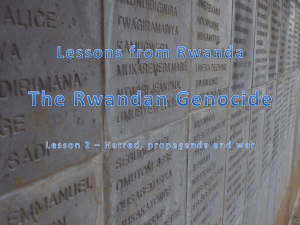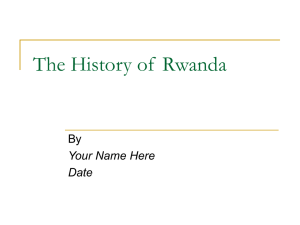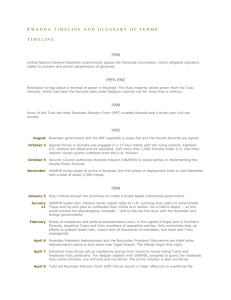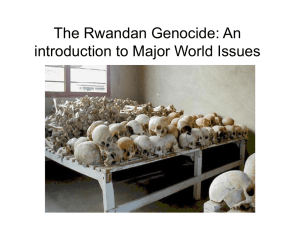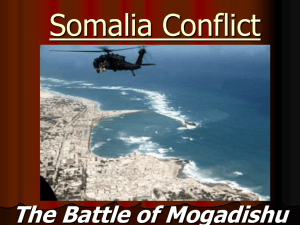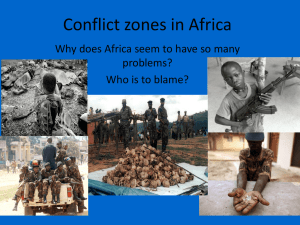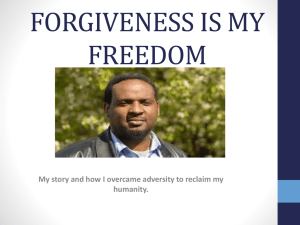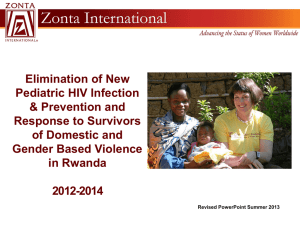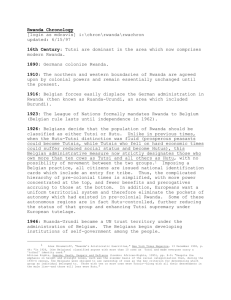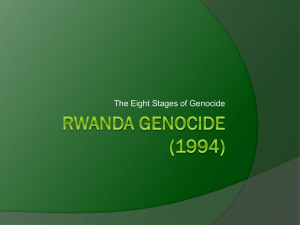RWANDA 20 YEARS AGO TODAY Medard Oct 15
advertisement
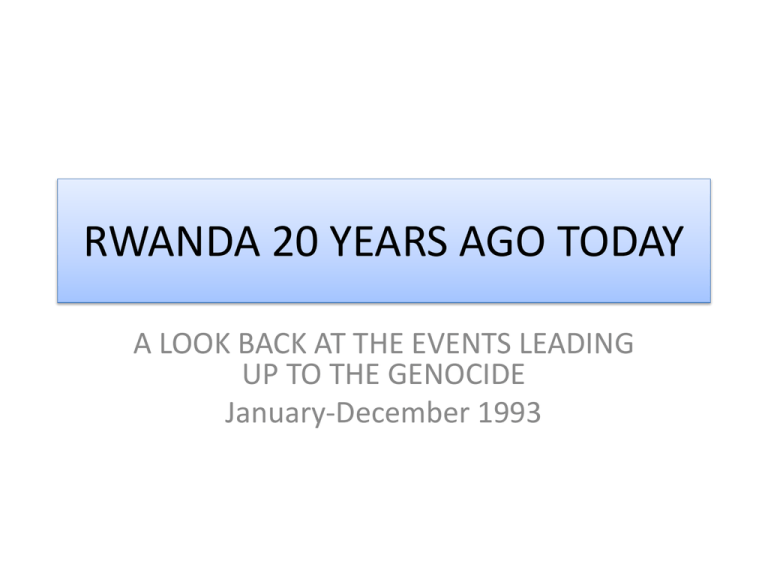
RWANDA 20 YEARS AGO TODAY A LOOK BACK AT THE EVENTS LEADING UP TO THE GENOCIDE January-December 1993 MEDARD NDUWAMUNGU SENIOR ANALYST WITH THE DEPARTMENT OF JUSTICE CRIMES AGAINST HUMANITY AND WAR CRIMES SECTION OTTAWA, ONTARIO, CANADA 1992 July, August, September, October • Negotiations between the Rwandan Government and the RPF began in July 1992. The First Protocol of the Arusha Accord was signed on 16 August 1992. • 21 September 1992, the Rwandan Army High Command issued a memorandum which ‘defined the enemy’. • End of October 1992, the Rwandan Government and the RPF signed the Second Protocol of the Arusha Accord. November • 15 November 1992, Habyarimana criticised the Arusha Accord and declared it to be a “scrap of paper”. By the same token he announced that an election will be held in the near future, in which the MRND militia, the Interahamwe, would serve as a striking force to ensure his victory. • 22 November 1992, Léon Mugesera gave his infamous hate speech in which he encouraged Hutu to kill Tutsi and deposit their bodies in the Nyabarongo River as a way of sending them back to Ethiopia. November • Mugesera’s speech unleashed attacks against Tutsi communities in north-western Rwanda including the communities of Gaseke, Giciye, and Karago. • The Minister of Justice, a member of the PL party, issued a warrant for Mugesera’s arrest. Mugesera, however, found refuge in a military camp where he went into exile. December • 31 December 1992, the Minister of Justice resigned. 1993 January • 7 – 21 January 1993, an International Commission on human rights abuses which conducted an investigation in Rwanda collected substantial evidence that linked President Habyarimana and his immediate entourage to atrocities against Tutsi and the political opposition. • 20 January 1993, a letter by Alain De Brower, political counsellor of the International Démocrate Chrétien (IDC), to the MRND, advised to explore a “permanent and open MRND-MDR collaboration”, to form an alliance of Hutu parties. February • 8 February 1993, the RPF launched a massive attack along the northern front line which forced the government troops to retreat. As a result, the civilian population from the Byumba prefecture fled south; they joined hundreds of thousands who were displaced earlier in the conflict. At that time, one seventh of Rwanada’ population was displaced (around one million). • End of February 1993, the French Minister for Cooperation, Marcel Debarge, met with Hutu parties and urged the formation of a “common front” against the RPF. March • 6 – 8 March 1993, after negotiations in Dar-es-Salaam, the RPF agreed to a cease-fire and pulled back to its original positions, leaving a sizable buffer zone between its lines and those of the government army. • Random violence against the civilian population in Butare, Gitarama and Kigali. • End of March 1993, Emmanuel Gapyisi formed a political movement/association/party, called Forum Paix et Démocratie, to gather those who were opposed to the RPF and Habyarimana regardless of party affiliation. May, June, July • 18 May 1993, a hit squad killed Gapyisi. The Forum collapsed. • 9 June 1993, an additional protocol of the Accord, related to refugees and displaced persons, was signed in Arusha. • 18 July 1993, Mme Agathe Uwilingiyimana is invited to form a government. • 19 July 1993, James Gasana, the then-Minister of Defence fled the country and found refuge in Switzerland. August • August 1993, radio station RTLM radio began to broadcast. • 3 August 1993, An additional protocol to the Arusha Accord related to the merger of the troops was signed. • 4 August 1993, the Arusha Accord was signed by Habyarimana and the RPF. • 5 August 1993, Faustin Twagiramungu became the Prime Minister in the transitional government. October • 5 October 1993, the Security Council established the UN Assistance Mission in Rwanda (UNAMIR) which included the deployment of more than 2,500 troops (UN Resolution 872). • 21 October 1993, Tutsi army officers in Burundi assassinated Melchior Ndadaye, Hutu President of Burundi. He was elected in June 1993 in a free and fair election. Immediately after the assassination, Burundi’s Hutu retaliated by killing Tutsis. • 23 October 1993,Hutu adherents met in Kigali to deplore Ndadaye assassination and to draw lessons from it. Arusha Accord was virtually dead. November • 1 November 1993, UAMIR troops began to deploy in Rwanda. • 17 – 18 November 1993, in a highly organised attack a group of unidentified assailants killed some 40 individuals in various communities in Byumba. UNAMIR investigated the atrocities without ever disclosing the results of the investigation. • 26 November 1993, RTLM called for the assassination of Prime Minister A. Uwilingiyimana and Prime Minister designate F. Twagiramungu. December • Early December 1993, The Interahamwe militia was in full training in at least three camps by Presidential Guard troops. • 15 December 1993, the French troops supporting the Habyarimana regime left Rwanda. • 28 December 1993, RPF troops arrived in Kigali.
